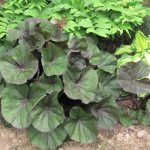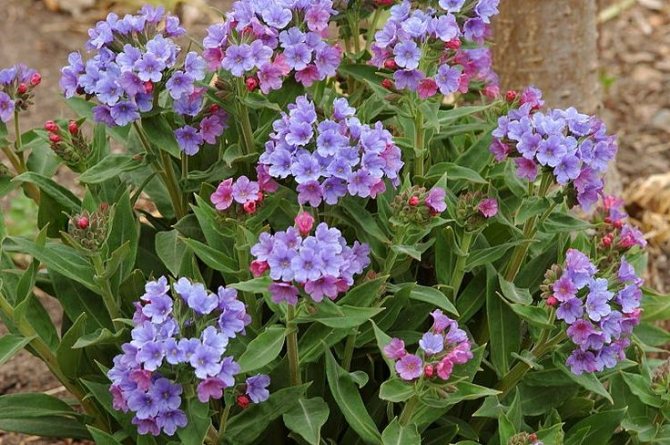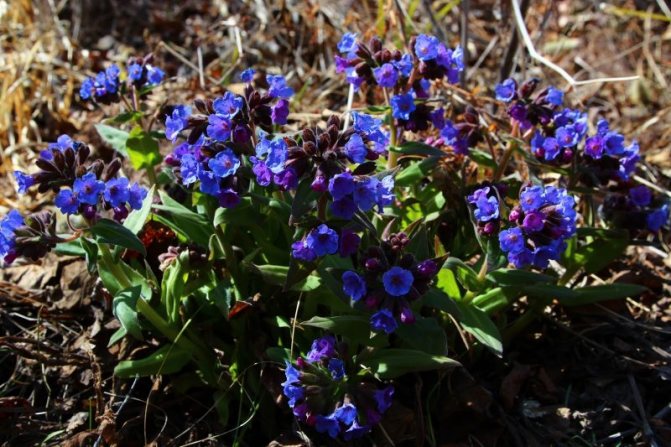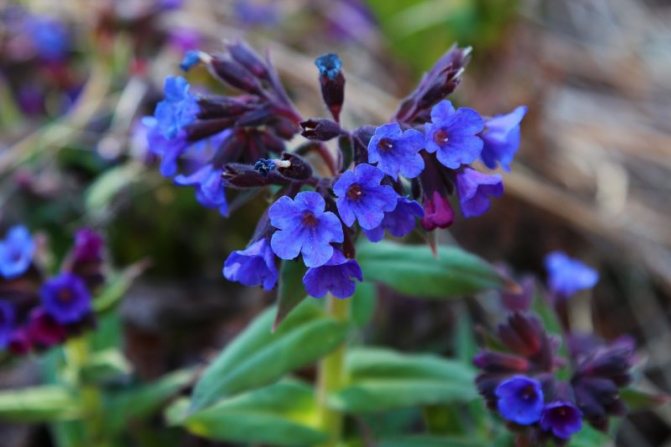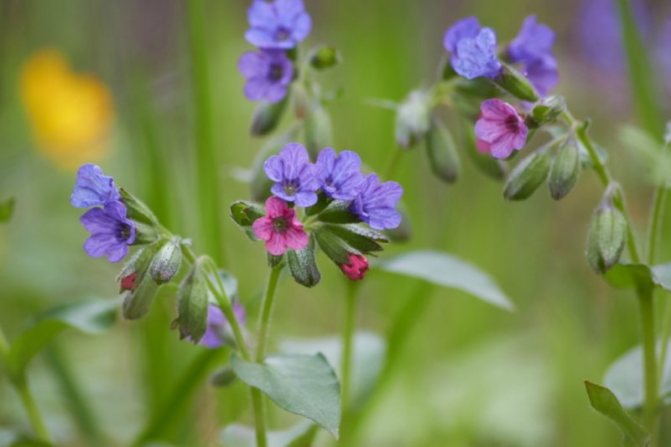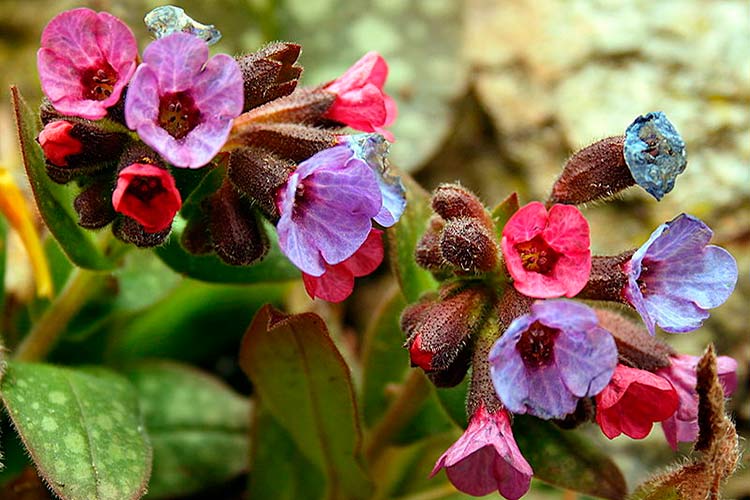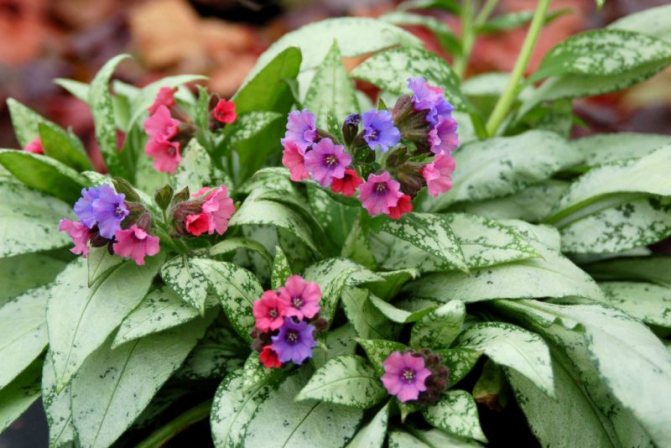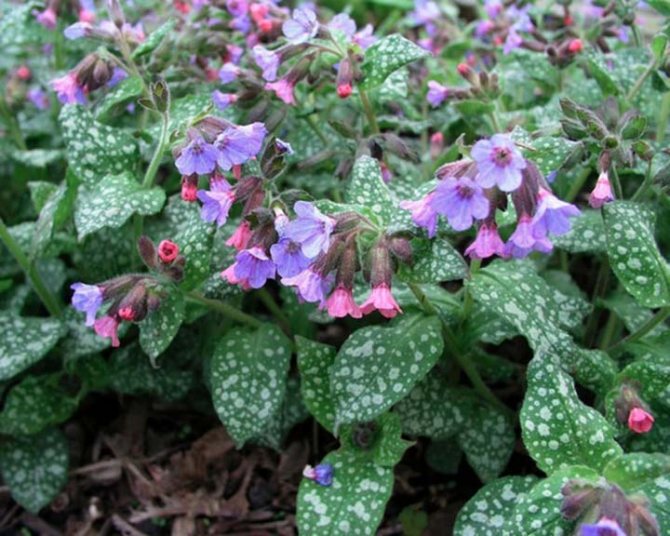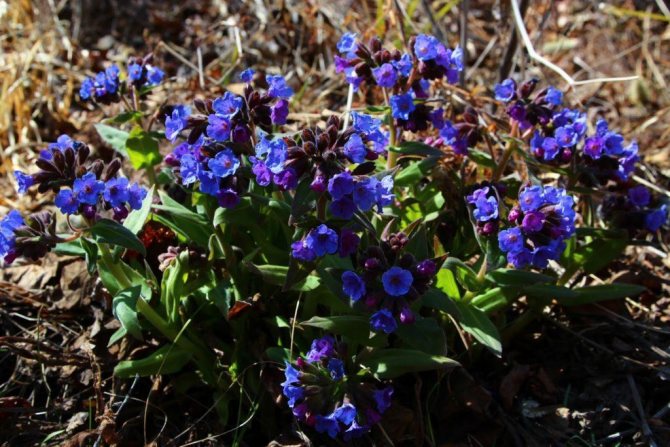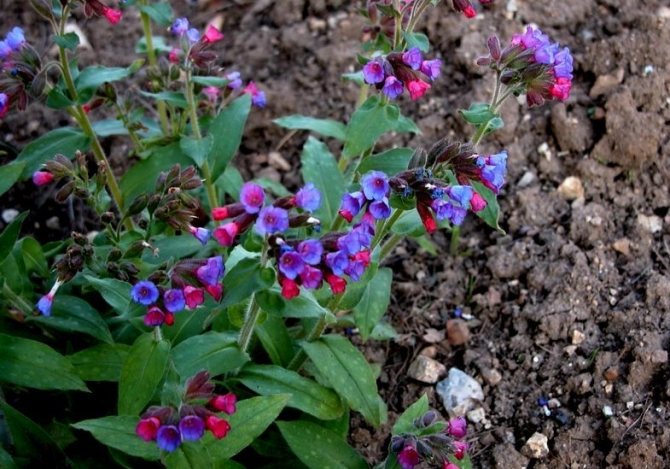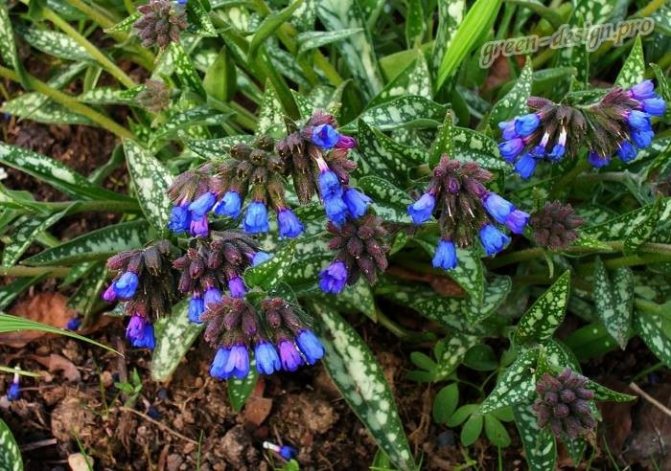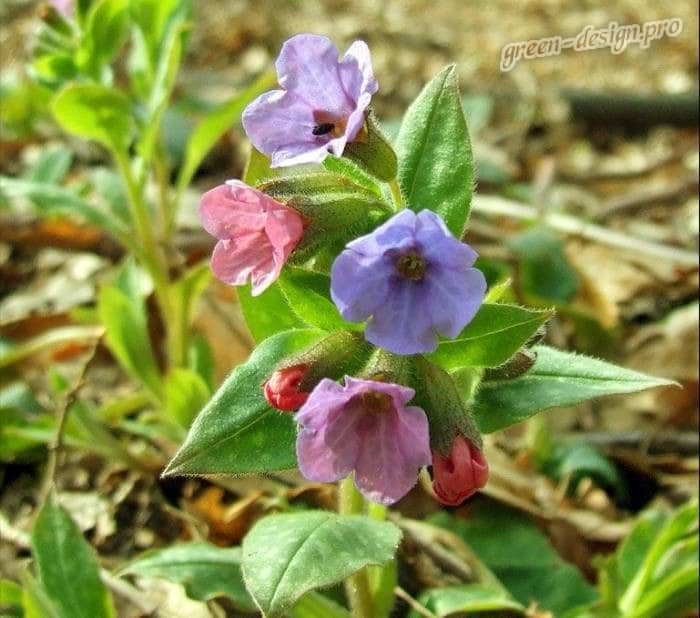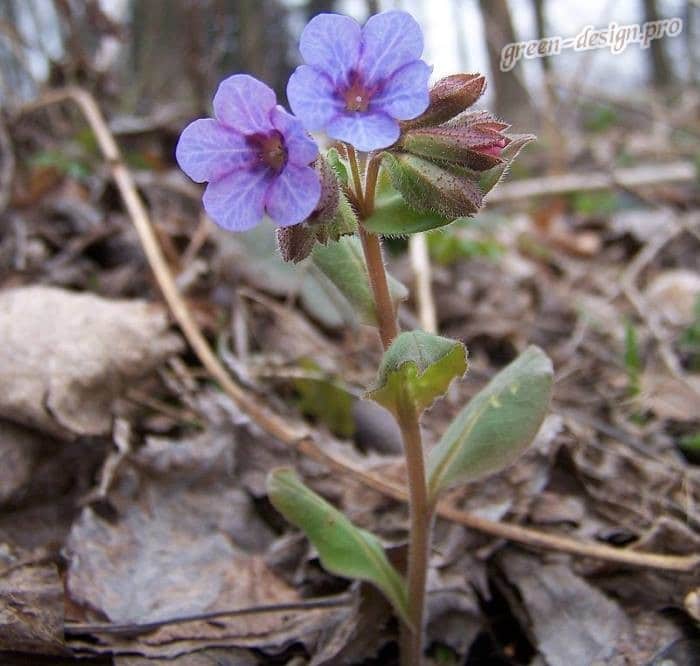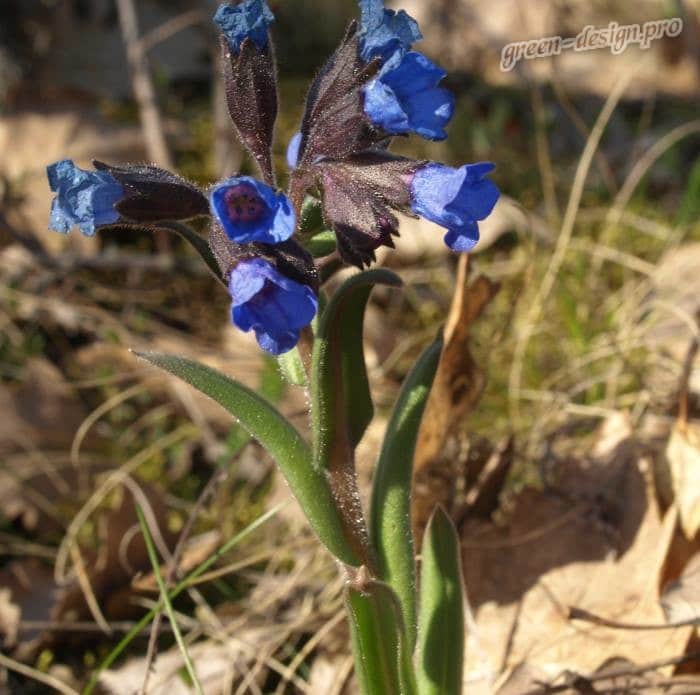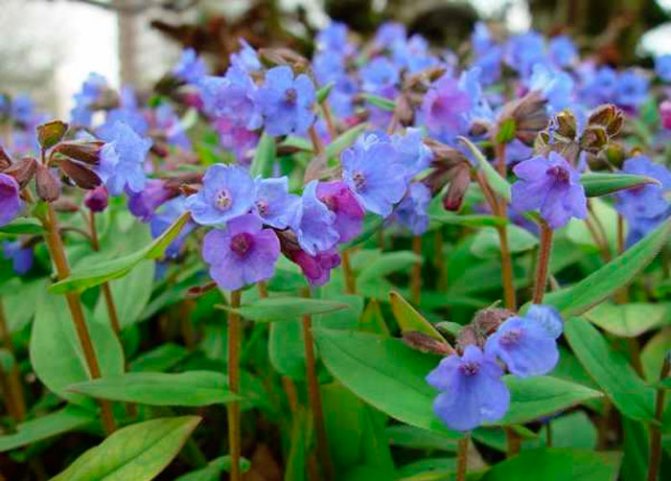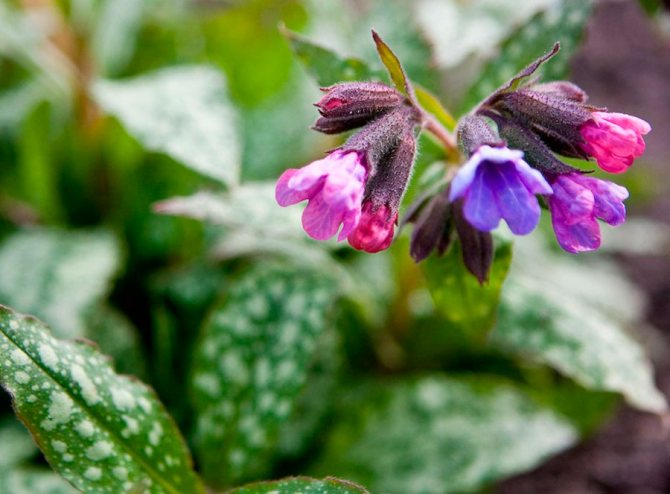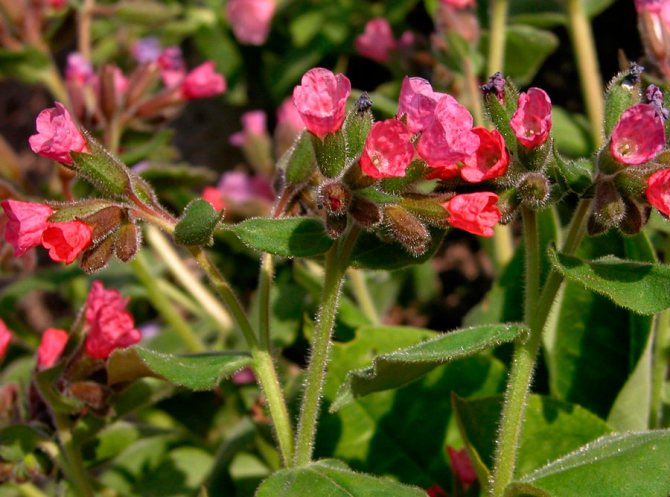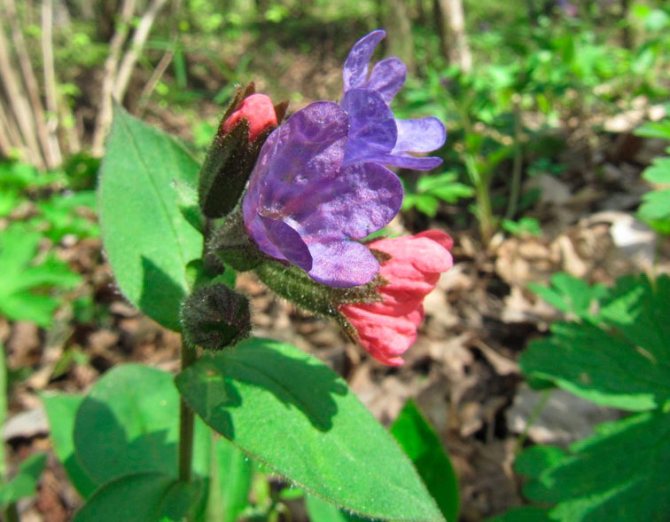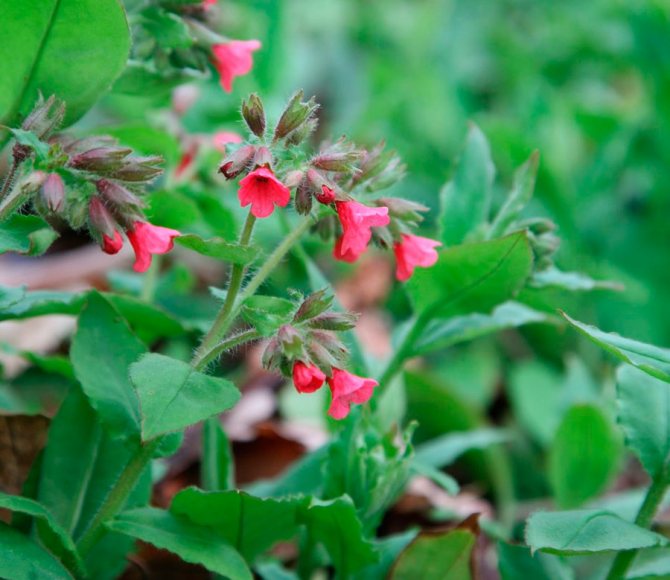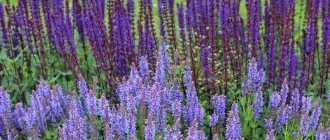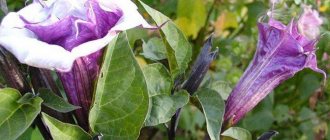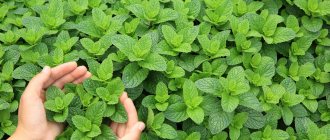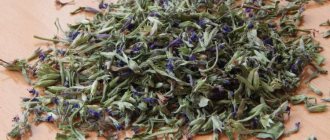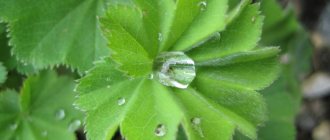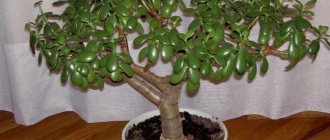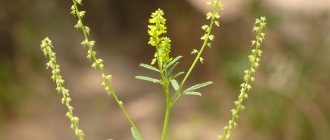Medunitsa is a representative of the Burachnikov family. This is a low-growing plant, the height of which does not exceed 30 cm. The flower has a stem covered with short hairs and a rather thick rhizome. Medunka leaves are sessile, with a delicate down, the lower ones have white spots. Crimson, purple or blue bell-shaped flowers are located on the tops of the twigs.
Lungwort bears fruit in July. Plant can be seen in mixed forest, on forest edges, clearings and in bushes. In former times, the flower was considered a modest representative of the forest flora. It was he who first appeared on the edges after the snow melted.
Until recently, hardly any gardener planned to grow this plant on his site, however, thanks to the breeders who cultivated wild lungwort, now the flower beds are full of variety of different types of flowers.
- 2 Medicinal properties
- 3 Selected species of lungwort
- 4 Growing lungwort
- 5 Care of lungwort flower
- 6 Reproduction
- 7 Application
Description of the plant
This flower has its own secret. As soon as the snow melts in the spring and the first rays of the sun come out, funny inflorescences in the form of curls make their way from last year's foliage. This is pulmonaria or, as we call it - "lungwort". You will find a photo of the plant and a description in our article. On one stem there can be blue, light blue, crimson, pink, white, lilac flowers that resemble tiny bells. There is a lot of sweet nectar in them, so the plant has also acquired the popular name "medunka" or "honey cake". First, pink-red bells appear, after pollination they turn blue-purple, as can be seen in the photo of lungwort. This trick tells the bees that the peduncles are already empty, without pollen.
What is the secret of the flower? The fact is that after pollination, a chemical reaction takes place, which changes the acidic environment of the plant sap to an alkaline one. This is what the multi-colored color of the lungwort is connected with: pink, lilac-purple, blue.
Another advantage of the plant is its foliage. Take another look at the photo of the lungwort. It has beautiful large leaves, collected in the form of a root rosette. They appear much later than the buds themselves, after the end of flowering. Ornamental leaves already hold out until frost. If the winter is warm, then they can survive green until spring. Photos of the lungwort flower will show you its appearance.
There is a legend that the blue bells contain the beginning of Adam, and the pink ones - Eve. Thus, the plant symbolizes the combination of opposites.
Pulmonaria is an annual or biennial herbaceous member of the borage family. It is they, as well as umbilicals, brunners, forget-me-nots that are considered his closest relatives. Pulmonaria (lungwort) got its name from the Latin word - pulmon. It means lung. The fact is that it was used to treat pulmonary diseases. Also, the leaves of the flower are like one half of this human organ.
In Russia, the plant was named "lungwort". Similarly, it is used in the scientific literature. After all, the flowers of the plant contain a large amount of nectar. Peduncles appear very early, which provides food for insects.
Pulmonaria is distinguished by a creeping, perennial, branched rhizome.She has erect, rough stems. Leaves are light green with spots, often pubescent. A flower in the form of a five-toothed calyx. As you can see, the botanical description of the lungwort and the photo with bells are harmoniously combined with each other and give us a complete picture of this plant.

Growing lungwort in the garden
Planting lungwort in the ground
The lungwort grows best in cool shade or partial shade in a humus-containing, loose sandy loam or loamy soil of an alkaline, slightly acidic or neutral reaction. In a sunny area, the flowers of the lungwort will not be so bright, since the plant does not tolerate direct rays and heat poorly. Before sowing seeds, the area allotted for lungwort must be dug up with organic fertilizer - compost or humus - to the depth of a shovel bayonet, while clearing the soil of weeds.
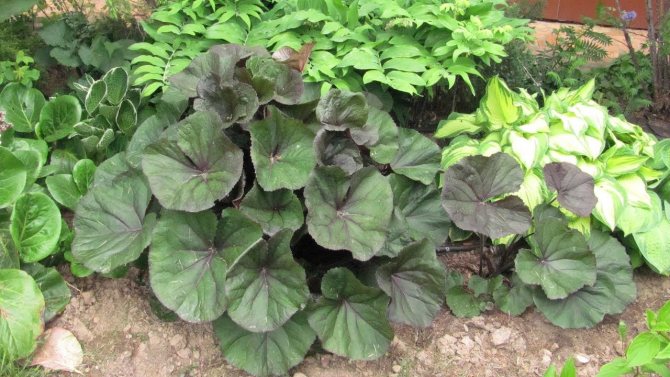

Lungwort is sown in open ground in spring, when the earth is saturated with moisture from melting snow. As soon as the top layer of the earth warms up and the threat of recurrent frosts has passed, they begin to plant seedlings, which can be purchased in a garden pavilion or in a well-established agricultural company, where they will tell you how to plant seedlings and how to grow them.
Inspect the seedlings carefully before buying and select only absolutely healthy ones, which are free from damage, signs of disease and the presence of pests, as well as the consequences of improper maintenance and poor care.
On a plot prepared and filled with fertilizers, at a distance of 20-30 cm from each other, dig holes so deep that the root system of seedlings with an earthen clod fits in them. If water can stagnate in this area, place a layer of drainage material in each hole - coarse sand, small pebbles or rubble. Place the seedling in the hole and fill the remaining space with soil, then compact the surface and water each bush with a moderate amount of water.
How and when to sow petunia, how to care
Care of lungwort in the garden
If you planted lungwort in the shade or partial shade, you almost never have to care for it. Water the plant regularly, keeping the soil on the site in a moderately moist state, but avoiding stagnation of water in the roots. Watering is especially important during the budding and flowering period. In shade and partial shade, the soil stays moist much longer than in the sun. To retain moisture in the soil of an area exposed to the sun, cover the surface with a layer of organic material up to 5 cm thick. Mulch will protect the soil not only from dehydration, but also from weeds. When the lungwort bushes mature, they no longer need watering so much.
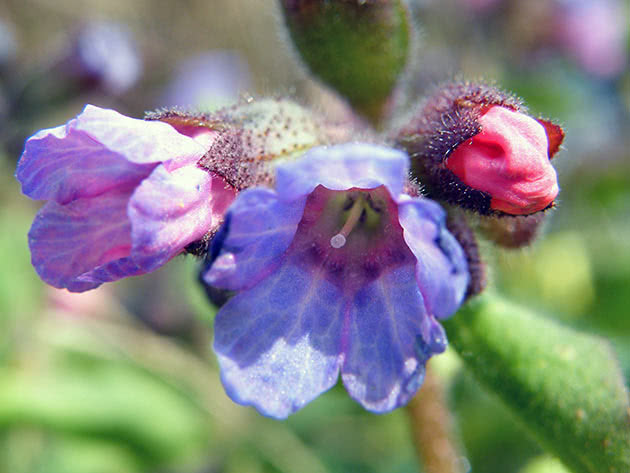

In the photo: How the lungwort blooms in the garden
Top dressing in the form of a solution of 15-20 g of complete mineral fertilizer in 10 liters of water is applied to the soil once a season in spring, when the intensive growth of new leaves begins in the lungwort. After flowering is complete you need to carefully cut the flower stalks from the bushes. Leaves that have lost their decorative effect can also be removed from the bush with a sharp knife or pruner.
- Bubbles: planting and care, reproduction and species
On the eve of winter, all lungwort are mulched with a layer of peat, and some species, for example, soft and lumpy lungwort, require more reliable shelter, for which you can use dry leaves, sawdust or needles.
Pests and diseases of lungwort
In general, lungwort is resistant to all diseases and most pests, however, if it is weakened by unfavorable weather conditions, improper maintenance or poor care, various infections can affect it: in a rainy summer or as a result of excessive watering, especially against the background of sudden temperature changes, the plant can get sick root rot or powdery mildew.Sick specimens must be removed from the flower garden and burned, and healthy plants must be thoroughly treated with sulfur-containing fungicides from powdery mildew, and copper-containing fungicides from root rot.
Of the pests, the danger to the lungwort is represented by gastropods - slugs and snails, the invasion of which usually occurs during a period of high humidity. If there are too many pests, they are destroyed with Thunder, using it in accordance with the instructions. But it is better to pick up slugs with your hands or dig in several cans on a site flush with the surface and fill them by a third with beer or fermented compote: slugs will surely crawl to the smell and fall into a trap from which they cannot get out.
Distribution area
Pulmonaria is of different types and is common in the temperate zone of Eurasia. The most common lungwort is soft, which grows in Western Europe and Asia Minor. Eastern Siberia is also considered to be the plant's distribution area. In our article you can find a description and photo of the soft lungwort.
For its growth, the flower chooses broad-leaved and coniferous mixed forests. It thrives best in partial shade, shaded and cool places. This plant is not used to the heat. He needs a temperate climate and a lot of moisture. The lungwort prefers sandy loam, loamy, slightly acidic, loose soils with humus. Growing in the shade, Pulmonaria has a beautiful pattern on the leaves and a rich color of inflorescences.


The process of harvesting plant materials
If lungwort is not grown in the garden, then you need to collect it in the forest, on forest edges and large glades. The plant can be found in meadows, in the lowlands of the slope and in clearings. The herb is most common in the forest and forest-steppe zone.
For medicinal purposes, all parts of the plant are harvested. Flowers and leaves are harvested and dried in spring or early summer, and the root is harvested in autumn. You can dry the plant in bunches, after cutting it at the root. Drying of leaves and flowers must be quick, otherwise parts of the plant may turn black and rot. The roots, on the other hand, dry out for a long period. Drying should be done in a well-ventilated place, out of direct sunlight. The herb is stored in boxes, which are lined with paper inside. When properly dried, the herb is odorless and light green in color.
Lungwort is eaten. For these purposes, the stems and root leaves are collected. Young shoots are also considered edible. They have, like mature lungwort herb, medicinal properties.
Contraindications and side effects are recommended to be considered before using the plant for medicinal purposes.
Types of lungwort
There are several types of medicinal lungwort, and breeders have also bred many decorative varieties for planting in flower beds. In pharmacology, it is used little, because there are many plants with more pronounced properties than pulmonaria. But in folk medicine, it is actively used. We will describe three main medicinal species. This is a medicinal lungwort, unclear and mild.
Medicinal pulmonaria can be found in the forests of Eastern and Central Europe, in Britain. On the territory of the Russian Federation, it grows in the Kaliningrad region. Medicinal lungwort is a perennial rhizome plant, reaching a height of up to 30 cm. It is characterized by erect stems covered with hairs. There are light spots on the leaves of lungwort. The leaves themselves are pubescent and rough. The flowers are located near the stem, resembling a bell with a double perianth.
In Western Europe, Asia Minor, Eastern Siberia, soft lungwort grows. It loves to grow in light, moderately dry areas where there are a lot of minerals. Its powerful brown roots have many adventitious branches. Sometimes the stems of this plant can reach 50 cm in height. The leaves are particularly soft, maybe that's why this species got its name.
In Eastern Europe, dark lungwort grows, which is also called obscure. It is a perennial plant with a brown thick root. Its stems are ribbed and slightly bent. They reach a height of 30 cm. Flowering begins immediately after the snow melts. This species has no leaf spots.
For decoration, gardeners use already modernized varieties. Especially loved the variety of sugar lungwort. And here are some more new varieties: Argentea, Regional Cay, Smokey Blue, Mrs. Kuhn, Little Star. This is not the whole list of varieties of pulmonaria.
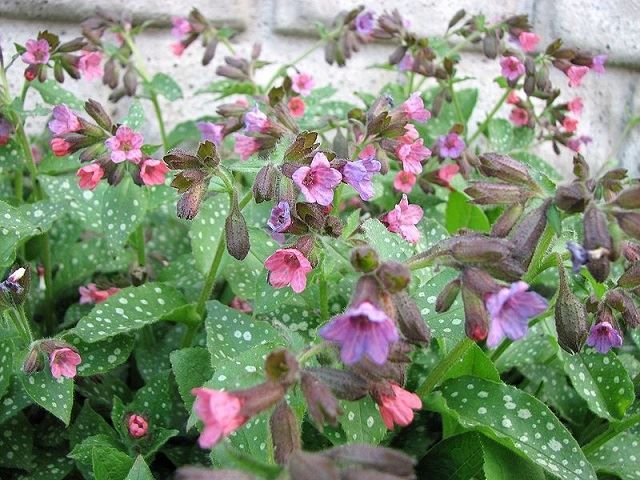

Chemical composition
The healing properties of lungwort are based on its chemical composition. The plant contains many useful substances, among which vitamins C and P are not the last. The herb contains calcium and potassium, as well as a whole set of trace elements: manganese, strontium, copper, iodine, silicon, titanium and iron. In addition, the culture contains rutin, mucous and tannins, flavonoids. It contains silicic acid, tannins, saponins, polyphenols and other equally useful components.
Features of planting and care
Lungwort are forest plants, they need coolness and lack of heat. To place bushes in garden areas, you need to choose rich, drained soil. It is better to plant a plant in summer. Bushes need to be placed between each other at a distance of 10 cm or more. In the heat and dry land, watering is required. This is especially true for the red variety.
Pulmonaria need regular watering and feeding. As soon as the flower stalks fade, they need to be cut off and the plant should be fed with mineral fertilizer.
Damp autumn promotes the appearance of powdery mildew or brown spot on the leaves. This is removed by ash. Slugs that appear on the leaves must be removed by hand or treated with sulfur.
For winter and spring, mulch should be poured around the bushes. It can be peat, wood chips, sawdust, chopped hay. Pruning the plant for the winter is not necessary.
In gardens, lungwort looks very good under trees. You can plant them under thuja, pines, firs. Crocuses, snowdrops, muscari, chionodox will go well next to them. In general, it is not demanding on growing conditions.
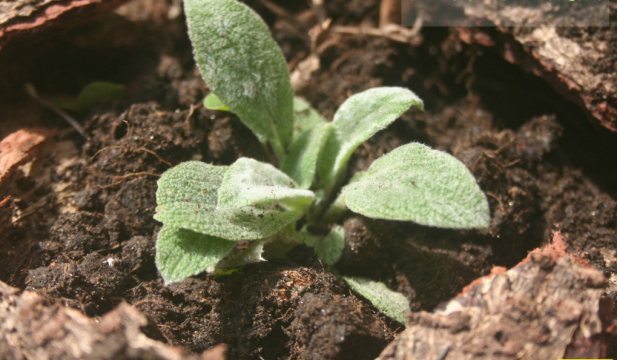

Care of the lungwort flower
In dry weather, the plant requires regular watering. Humus should be added from time to time. During the period of intensive foliage growth, the grass must be fed with mineral fertilizers. at the rate of 15-20 grams per 10 liters of water... A portion is enough for 1 m2. Overgrown shoots, if necessary, can be chopped off with a shovel.
Varieties and hybrids of m. Soft and m. Valovid need additional shelter for the wintering period. When preparing for winter, it is advisable to mulch all types of lungwort with peat.
In no case, do not pick off the leaves of the narrow-leaved lungwort.
Reproduction
Red and medicinal lungwort reproduces by dividing the rhizome. Sugar, long-leaved and indistinct, requires dividing the bush in August or September. The plots are immersed in the soil to a depth of 5 cm. The roots are slightly shortened before planting. If the plants do not take root before the heat, then they are covered from the scorching sun. It is difficult to propagate lungwort by seeds. Experienced gardeners make planting seeds in boxes or pots in the summer. For this, freshly harvested material is used. The flowering of young bushes occurs at 3 years. In the long-leaved and sugar lungwort, self-seeding occurs in summer.
Care Tips
The lungwort is hygrophilous, it requires regular watering, especially during drought periods, but it should beware of stagnant water. Despite the plant's undemandingness to the soil, it is still advisable to add humus every season, and around July, when foliage is actively growing, feed it with mineral fertilizers.
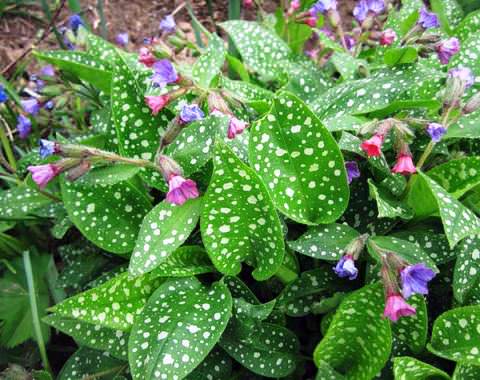

You can safely pick off old leaves. After the bush has faded, it is better to completely cut off the peduncle.For the winter, the plantings are mulched with peat, so they can easily endure frosts. True, the soft and lumpy lungwort is additionally covered with a layer of dry foliage, these species are more delicate.
The plant is rarely sick, but sometimes it still suffers from powdery mildew. It is better to remove and burn very infected bushes immediately. If the disease has just begun to develop, it is enough to cut off the affected leaves and treat the plantings with special preparations. In addition, snails and slugs do not mind eating bushes. The less planting density and the more thoroughly weeds are removed, the less the likelihood of attacks by these pests.
List of useful properties of the plant
Here are the beneficial effects of medicinal lungwort:
- softening;
- astringent;
- anti-inflammatory;
- diuretic;
- hemostatic;
- wound healing;
- antiseptic;
- expectorant;
- pain relievers;
- enveloping;
- hemostatic.
Pulmonaria contains anthocyanins, flavonoids, allantoin, saponins, mucus. It also contains a lot of ascorbic, silicic acid, carotene, tannins, rutin, polyphenols, iodine.
And here's how the medicinal lungwort, rich in manganese, potassium, copper, calcium, iron, vanadium, titanium, silver, nickel, affects the body:
- normalizes the processes of recovery and oxidation;
- promotes the work of the pancreas;
- prevents the formation of oncology;
- normalizes metabolism;
- helps to synthesize thyroid hormone;
- strengthens bones;
- has a beneficial effect on the functioning of the nervous system;
- removes puffiness;
- does not allow atherosclerosis to develop;
- normalizes pressure;
- serves to strengthen the immune system;
- helps in the release of hemoglobin.
Properties of lungwort - harm and benefit
Medicinal properties of lungwort
The lungwort contains tannins, mucus, tannins, saponins, iron, alkaloids, anthocyanins, flavonoids, silicic and ascorbic acid, carotene, rutin and other substances useful to humans. Tannins and saponins act as an expectorant and emollient to help you feel better for any respiratory ailment. The lungwort also has anti-inflammatory, bactericidal, diuretic, astringent, antiseptic, hemostatic and enveloping effects. It helps to improve the functioning of the body's immune system.
The use of lungwort preparations is advisable for gynecological problems, oncological diseases, hemorrhoids, skin diseases, bleeding, diseases of the respiratory system, stomach and intestines, for the prevention of heart attacks and strokes. However, in order for the treatment to give the desired result, you need to know the rules for using lungwort, therefore before starting the course, it is better to consult a doctor.


Only the use of lungwort in field conditions as an external agent does not require the supervision of a specialist: treat a cut or wound with freshly squeezed juice from a lungwort, which has a hemostatic, astringent and antiseptic effect. If the surface of the wound is large, chop the leaves and stem of the plant with a knife and apply this gruel to the wound. Well heals the juice of lungwort, calluses and cracked heels.
Folk recipes
For the treatment of herbal lungwort, tinctures, infusions, decoctions, juice, tea, dietary supplements are used. Acute respiratory diseases, inflammation of the respiratory tract mucosa, dry cough, hoarseness, bleeding, hemorrhoids are treated with pulmonary infusion. It also helps with urolithiasis and kidney inflammation. The infusion is prepared at the rate of a glass of boiling water and a tablespoon of dry herbs. All this needs to be insisted for two hours. It is taken three times a day, 50 ml.
Bronchitis, bronchial asthma, pneumonia, anemia are treated with alcohol tincture from lungwort. For this, dry leaves of the plant are used. For half a liter of vodka, 50 g of crushed raw materials are enough. It has been insisted for two weeks.
Oncological diseases, leukemias, thyroid diseases, tuberculosis are eliminated with the juice of medicinal lungwort. It is very rich in iodine. The stems and leaves of the plant are passed through a meat grinder, and then the juice is squeezed out through cheesecloth. To keep it for a long time, it is alcoholized with vodka in a 1: 1 ratio. Before taking the tincture, dilute with water 1: 1.
Today dietary supplements are made from lungwort. These are small briquettes of 3-5 g. One is enough for brewing a glass of boiling water. The duration of treatment with such a drug is one month.
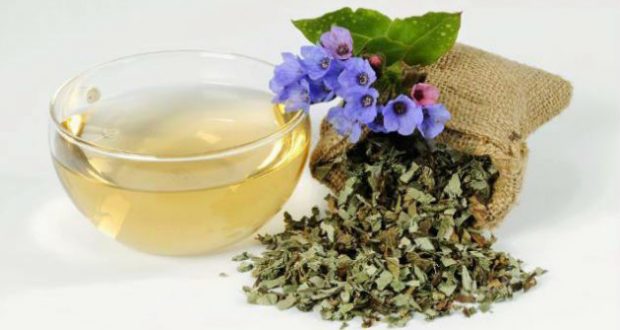

Medicinal properties
The healing properties of the plant are legendary. It is known that Paracelsus, a famous healer of antiquity, used lungwort as a remedy for pulmonary diseases. And the herbalist Hildegard Bingent, who lived in the 11th century, was one of the first to use the plant for the treatment of lung diseases.
Thanks to the various trace elements that make up the lungwort, the plant is successfully used in regulating the activity of the endocrine glands, stops bleeding and enhances the formation of blood cells. The presence of tannins in the herb explains its anti-inflammatory and astringent properties. The infusion of the plant is also used for stones in the bladder and kidneys, bloody urine and as a diuretic (for inflammation of the kidneys).
Infusions and decoctions from the plant have anti-inflammatory and diuretic properties, have wound healing and antitussive action... A leaf of lungwort, applied to the cut, promotes its early healing, showing even greater effectiveness than using plantain or Kalanchoe.
All parts of the plant are used as a healing material: leaves, roots and buds. Raw materials are dried at a temperature not exceeding 40 ° C in a well-ventilated area and stored in fabric or paper bags, after being chopped up.
Infusion of herbs is widely used in the treatment of the following diseases:
- laryngitis;
- pleurisy;
- bronchial asthma;
- bronchitis;
- cardiovascular diseases;
- uterine bleeding;
- tuberculosis;
- bronchitis;
- thrombophlebitis;
- BPH;
- diseases of the thyroid gland;
- anorexia;
- pneumonia;
- anemia;
- kidney disease;
- inflammation of the bladder;
- dysentery;
- hemorrhoids;
- purulent wounds, ulcers, abscesses.
To prepare the infusion, you need to take 1.5-2 tbsp. l. chopped dry grass and pour boiling water (2 tbsp), leave for 2 hours, strain. Take 3 times a day, 20-30 minutes before meals, 0.5 cups.
For rinsing, baths, washing and lotions, use an infusion of higher concentration (4 tbsp. L. Herbs / 2 tbsp. Boiling water).
Lungwort juice is used as an antiseptic for wounds... For the speedy healing of pustular wounds, it is necessary to grind the leaves and apply the resulting gruel to the wound.
Regardless of the duration of the use of lungwort as a therapeutic agent, no side effects were noticed.
In the treatment of lung diseases, the plant is recommended to be used in conjunction with herbal infusions that strengthen the immune system: action; rosehip; black elderberry syrup; echinacea purpurea; clover; needles; currants, etc.
To medicinal types of lungwort include the following:
- sugar honeycomb;
- red;
- long-leaved;
- softest;
- unclear;
- medicinal;
- soft.
Although all these varieties have different properties and have different effects on the body, they are called by one phrase: medicinal lungwort.
Valuable honey
Beekeepers appreciate lungwort. She has an early flowering (April - early May), lasting more than a month. During this time, the bees manage to collect a lot of nectar. These flowers are loved not only by these insects, but also by bumblebees.
Honey from lungwort is very valuable for the bees themselves, because at the beginning of May, the queens lay eggs, and the forage bees need to replenish their strength.
The spring harvest of a healthy product is very valuable. Such honey strengthens the body well, eliminates coughs, colds.

